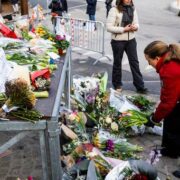October 1987 crash in historical perspective

On Oct. 19, 1987, following three days of decline in the New York stock market, the Hong Kong market dropped 10.5 percent after a rise of 89 percent in the last 12 months. Oct. 19 was Black Monday for New York, which triggered a worldwide stock crash.
In United States dollars terms, eight global stock markets declined by 20 percent to 29 percent, three by 30 percent to 39 percent, and three (Hong Kong, Australia, and Singapore) by more than 40 percent. The total losses were estimated at $1.7 trillion or just under 10 percent of world GDP in 1987.
The following Tuesday, the chair of the Stock Exchange of Hong Kong informed the financial secretary that the SEHK would suspend trading for the rest of the week, with the Hong Kong Futures Exchange (HKFE) following suit. There was fear of panic selling, disorderly markets, and inability to settle as clients were not meeting their commitments.
The global meltdown was halted by the Fed stepping in to provide liquidity, since everyone remembered the October 1929 Great Crash, which marked the beginning of the 1930s Great Depression. On Nov. 16, 1987, the governor appointed the Securities Review Committee (SRC) to review the constitution, management, and operations of the two exchanges and their regulators.
The SRC chair was Ian Hay Davison, who was formerly managing partner at Arthur Andersen, the leading US/UK firm of chartered accountants, also chief executive of Lloyds, the London insurance market. The Davison Report essentially concluded that “the concept of self-regulation and market self-discipline had failed to develop in Hong Kong. What is equally unfortunate is that, faced with this, the supervisory bodies charged with overseeing the markets had lost effective control.”
It recommended the establishment of an independent securities market regulator, which became the Securities and Futures Commission, established in May 1989, celebrating its 35th anniversary this year.
Since the 1987 crash, financial crises seemed to repeat every 10 years, with the Asian financial crisis occurring in 1997/1998 and the US sub-prime crisis, global financial crises of 2007/2008.
Each financial crisis ended up with massive central bank intervention and regulatory reform, but the financial markets kept becoming more complex, interconnected, and entangled. The 10-year crisis pattern was somewhat broken when no major financial crisis happened in 2018, mainly because central banks have learned to step in to provide massive liquidity through quantitative easing or balance sheet expansion. Curiously, in 1987 the SEHK market cap ($54 billion) was already 106 percent of Hong Kong GDP.
It was in recognition of the interconnectedness of stock and financial markets that the SEHK, HKFE, and Hong Kong Clearing were merged into the Hong Kong Exchanges after their demutualization and listing in March and June 2000 respectively.
Since then, the landscape of global financial markets was transformed profoundly, as turnover in volume, value, and speed rose with the addition of new derivatives and new technology. As exchange traded funds reach market value of $14 trillion and cyber-currencies now are valued at $2.2 trillion, new tech-driven market makers like Jane Street and Citadel Securities, which trade across multiple markets, are rivaling established investment banks in market power and profitability, as reported in the Financial Times.
In China, the joint announcement by the heads of the People’s Bank of China, the National Financial Regulatory Authority, and China Securities Regulatory Commission, which preceded the stock market run-up in Hong Kong and Mainland stock markets, showed how the authorities understand that banking, insurance, fund management, securities markets, and real estate are deeply interrelated.
Financial markets are complex ecosystems because they are deeply entangled with each other, with foreign markets influencing domestic markets and vice versa. Add to this mix, the rise of deep technology, artificial intelligence, demographics, geopolitical rivalries, and natural disasters and events make the need to understand what is happening, act fast, and address key structural issues more important than ever.
The legacy of silo’ed, top-down bureaucracies and specialist agencies to manage deeply entangled financial institutions all encroaching in each other’s markets all, is no longer adequate to cope with the emergence of new products, markets, and institutions that arbitrage new regulations faster than lawmakers can manage. Few can understand the complexity of market products or their rules and regulations.
There is a bitter lesson from financial crash history. If you don’t reform early enough, financial crises force you to reform. It’s not just the instant market volatility that matters, there are deep structural forces at work which we need to understand, sometimes beyond the powers of any single national regulator. Surviving such complexity needs the humility to listen to how markets are changing by the minute. Asia News Network
—————-
Andrew Sheng is former chair of the Hong Kong Securities and Futures Commission. The views expressed are entirely his own personal views.

















